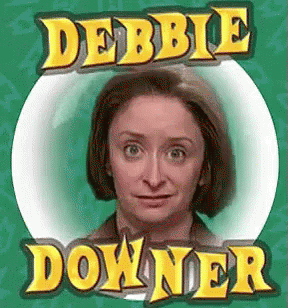Blog Short #106: 2 Cognitive Distortions That Paint Your World Negative

Photo by mohd izzuan, Courtesy of iStock Photo
If you’re interested in psychology, you’ve likely heard of Cognitive Behavioral Therapy – CBT for short. It’s a method of uncovering distorted thought patterns that affect your emotions and perceptions.
That’s a quick definition and doesn’t include anything about the process, but it gives you the basic idea.
Most clinicians agree that there are fifteen cognitive distortions that people most commonly use. Knowing them is helpful so you can be aware of when you use them and how they color your world. If you catch them as they come up, you can correct them and get a more accurate picture of how things are.
 Today I’m going over two of them that paint life in a negative light. If you’re familiar with Saturday Night Live, you’ve likely seen an older skit with a character named “Debbie Downer” played by Rachel Dratch. She’s the poster child for these two distortions!
Today I’m going over two of them that paint life in a negative light. If you’re familiar with Saturday Night Live, you’ve likely seen an older skit with a character named “Debbie Downer” played by Rachel Dratch. She’s the poster child for these two distortions!
They’re called “mental filtering” and “disqualifying the positive.” Let’s take them one at a time.
Mental Filtering
Mental filtering means picking out a single negative detail in any situation and focusing on it exclusively so that your overall perception is colored by it.
You sleep through your alarm and arrive late at work, so you decide the entire day is a wash.
You go out to dinner with friends, and one of them seems more distant than usual. You decide none of them actually like you and probably wish you weren’t there.
You give a talk to your colleagues at work. You stumble once during the presentation but recoup quickly. After the talk, everyone tells you how helpful the presentation was and what a good job you did, but you’re stuck on the single stumble you made, and ask people if they didn’t notice how you screwed up.
In these cases, you’ve honed in on one negative event or detail and used it to color the entire experience. A common metaphor is watching a single drop of ink released into a glass of water darken all of it.
Mental filtering is most apt to occur when you’re already in a bad mood or feeling depressed or anxious.
Another cause can be an underlying belief that filters through most of your perceptions. For example, you might believe you’re not good enough, not likable, or competent, and these beliefs alter your perceptions of events. You’re more likely to interpret details that confirm and magnify your views rather than see the bigger picture.
Now let’s go to the second cognitive distortion.
Disqualifying the Positive
With mental filtering, you focus on something negative to the exclusion of the positive. “Disqualifying the positive” is just the opposite. You start with something positive and discount it as though it doesn’t matter or hold any weight. It’s an underhanded way of leaning into the negative.
You get a coveted promotion at work and explain it as “My boss felt sorry for me” or “He didn’t have anyone else to hire.”
Someone compliments you on how articulate you are, and you pass it off with, “Oh, they’re just being nice.”
You get an A on an exam you studied diligently for and say, “I lucked out. It was easy. I bet everyone got an A.”
In each case, the positive is minimized and discounted. Sometimes people use this distortion as a means of staying humble. However, this is different than genuine humility. Being truly humble includes affirming your strengths and achievements, but without inflating your ego.
Disqualifying the positive is essentially removing it instead of a direct negative take. There are several reasons you might do that. For example:
- To avoid disappointment in the future.
- Not having to live up to the same expectation again.
- To reflect a negative view of yourself or a belief you hold.
In all of these cases, the underlying cause of engaging in the distortion is to protect yourself from either fear, disappointment, or expectations you might not be able to fulfill.
So what should you do to counteract?
Before I talk about strategies, let’s outline a few essential points.
1. Sometimes situations are negative. Should I ignore that and always try to be positive?
No, and this is an important point. You should seek reality, meaning getting the broadest picture of what is. If something is adverse, you need to see that. And if something is positive, you also need to see that. But that’s not all: You must also see all the grays in between. Seeing “what is” is the best and healthiest option. The key is to avoid looking at things through your preconceived notions or current emotional status.
2. Cognitive distortions can be positive as well as negative.
We usually go more toward the negative because of our natural negativity bias, but we can also get caught up in positive distortions. A good example is magical thinking, where you ignore alarming facts of a situation and pretend everything is rosy.
The goal is to see what’s accurate as best you can and react with deliberation rather than reflexively.
The strategies below will help you with that.
Strategies
The primary strategy is something called cognitive restructuring. It’s a more involved process than I’m giving you today, but here’s the gist of it.
Step 1: Be aware.
When you’re aware that you’re using a cognitive distortion, stop yourself momentarily and label it. Catch yourself in the act and interrupt your train of thought.
Step 2: Challenge it.
Next, challenge the accuracy of the distortion. Go through your thought processes and ask yourself how valid your assumptions are. Measure them against facts. If you sleep through the alarm and arrive late to work, ask yourself what else happened that day. What went right? Were there positives as well as negatives? What did you get done or accomplish? Asking questions that challenge the initial thought usually alters your perception based on the new information.
Step 3: Reframe it.
Now that you’ve taken a closer and broader look at your thought(s), reframe it to include the new evidence you’ve uncovered during your investigation. You might say, “Well, I did have a late start, but despite that, I got a significant amount done today. Maybe not as much as I might have, but I feel good about what I did.”
Reframing helps you formulate a realistic and more accurate picture of what occurs, which also keeps your emotions in check and appropriate to the reality of the situation. When done correctly, this process helps you see your thought processes and feelings from a distance so that you can evaluate them for accuracy and take actions more deliberately based on what you find out.
When to Get Help
If you use either of these cognitive distortions often, it’s a good idea to try some therapy. You need to uncover the issues and beliefs underlying your regular use of them. The distortions are not the source of the problem. The cause is more likely trauma of some sort, relationship issues, historical problems growing up, or other experiences you’ve had that have left an imprint. This is where CBT has limitations. It’s great for working on the distortions but not so much for uncovering and working with underlying issues and triggers.
That said, I’ll go through the rest of the cognitive distortions over the next several months because I think it’s beneficial to know about them and become familiar so you can catch yourself when you use them and make corrections.
That’s all for today.
Hope you have a great week!
All my best,
Barbara